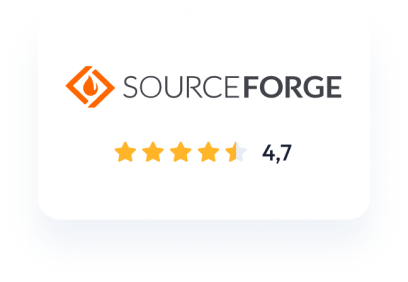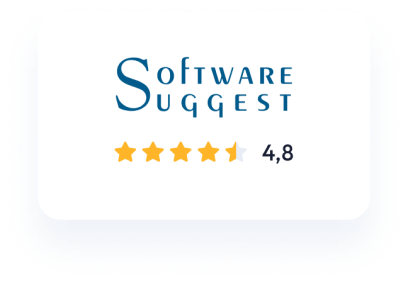
Table of Contents
Common Marketplace Business Models
- #1. Commission-Based Marketplace Business Model
- #2. Listing Fee Model
- #3. Subscription-Based Model
- #4. Freemium Model
- #5. Advertising and Sponsorship Model
- #6. Affiliate Marketing Model
Choosing the Right Marketplace Business Model for Your Business Goals
Why Is CS-Cart Multi-Vendor One of the Best Platforms for Diverse Marketplace Business Models?
In the dynamic landscape of marketplaces, the foundation for success lies in a well-crafted successful marketplace business model. A business model essentially serves as the blueprint that outlines how a marketplace intends to generate revenue. It's the strategic roadmap that dictates the financial dynamics between the platform, buyers, and sellers.
Imagine a marketplace business model as the navigational system of a ship—plotting the course to profitability in the vast sea of online commerce. For a marketplace, selecting the right online marketplace business model is akin to choosing the most efficient route—one that not only sustains the platform but also creates a thriving ecosystem for its users.
A marketplace business model is basically how your marketplace makes money for you.
The importance of this decision cannot be overstated. A well-chosen, successful marketplace business model not only ensures the financial health of the online marketplace but also determines the nature of interactions among participants. It shapes the dynamics of transactions, defines the value offered to users, and ultimately plays a pivotal role in the sustainability and growth of the platform.
In this guide, we will delve into the intricacies of various proven monetization marketplace business models for marketplaces, exploring their nuances, successes, and potential pitfalls. By understanding the significance of selecting the right business model for marketplaces, marketplace entrepreneurs can chart a course towards sustained success in the competitive seas of business to business and business to consumer online commerce.
Common Marketplace Business Models
Let's talk about how marketplaces make money. We'll explore the basic ways, like when they take a bit of money from each sale or when you pay a monthly fee, and more advanced non-obvious ways. Understanding these ways can help us see how online shopping on marketplaces works and why it's successful.
#1. Commission-Based Marketplace Business Model
A commission-based marketplace business model is a straightforward and widely adopted approach where the platform earns revenue by taking a percentage cut from every successful transaction that occurs between buyers and sellers. This revenue model aligns the interests of the online marketplace with the success of its users.
In this revenue model, the online marketplace essentially acts as a facilitator, connecting buyers with sellers. When a successful transaction occurs—be it a product sale, service provision, or any other exchange—the marketplace takes a predetermined percentage of the transaction value as its fee. This percentage can vary depending on the type of products or services offered.
Examples:
- Uber: Uber, a prime example of a commission-based revenue model, charges drivers a percentage of each fare for using its platform to connect with riders.
- Etsy: The e-commerce platform Etsy charges sellers a percentage fee for each item sold on its platform, aligning its revenue model with the success of its community of artisans and crafters.
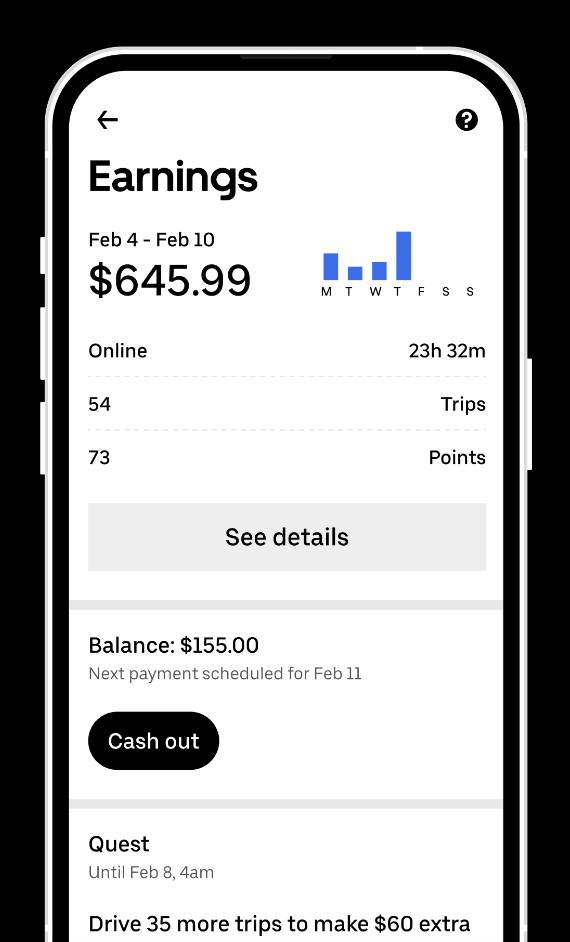
Uber charges drivers a percentage of each fare
Pros:
- Aligned Incentives: The success of the online marketplace is directly tied to the success of its users, fostering a collaborative ecosystem.
- Scalable: As transactions increase, the revenue of the marketplace also grows proportionally, making it a scalable business model.
- Low Entry Barrier: Sellers often appreciate this marketplace model as they only pay a fee when they make a sale, reducing the upfront costs.
Cons:
- Dependency: Both buyers and sellers may feel the pinch of transaction fees, potentially leading to dissatisfaction and seeking alternatives.
- Pricing Disputes: Determining the fair percentage for transactions can be a point of contention and might lead to disputes between the marketplace and its users.
- Competition: In highly competitive markets, users may migrate to platforms with lower transaction fees, impacting the successful marketplace business model's market share.
In a commission-based model, the platform makes money by taking a percentage from each successful transaction between buyers and sellers.
#2. Listing Fee Marketplace Business Model
A listing fee model in eCommerce marketplaces involves charging sellers a fee to list their products or services on the platform. Essentially, sellers pay a price upfront to showcase their offerings to potential buyers. This revenue model is like renting shelf space in a virtual store.
In the listing fee model, sellers pay a set amount for each item or service they want to feature on the platform. This payment gives them visibility, allowing buyers to browse and consider their offerings. It's a bit like paying rent for a physical store shelf but in the digital realm.
Examples:
- Amazon: Professional sellers do not have to pay a per-item fee, while individual sellers are charged $0.99 for each item sold.
- Etsy: Etsy charges a $0.20 listing fee for each item posted, regardless of whether or not the item sells.
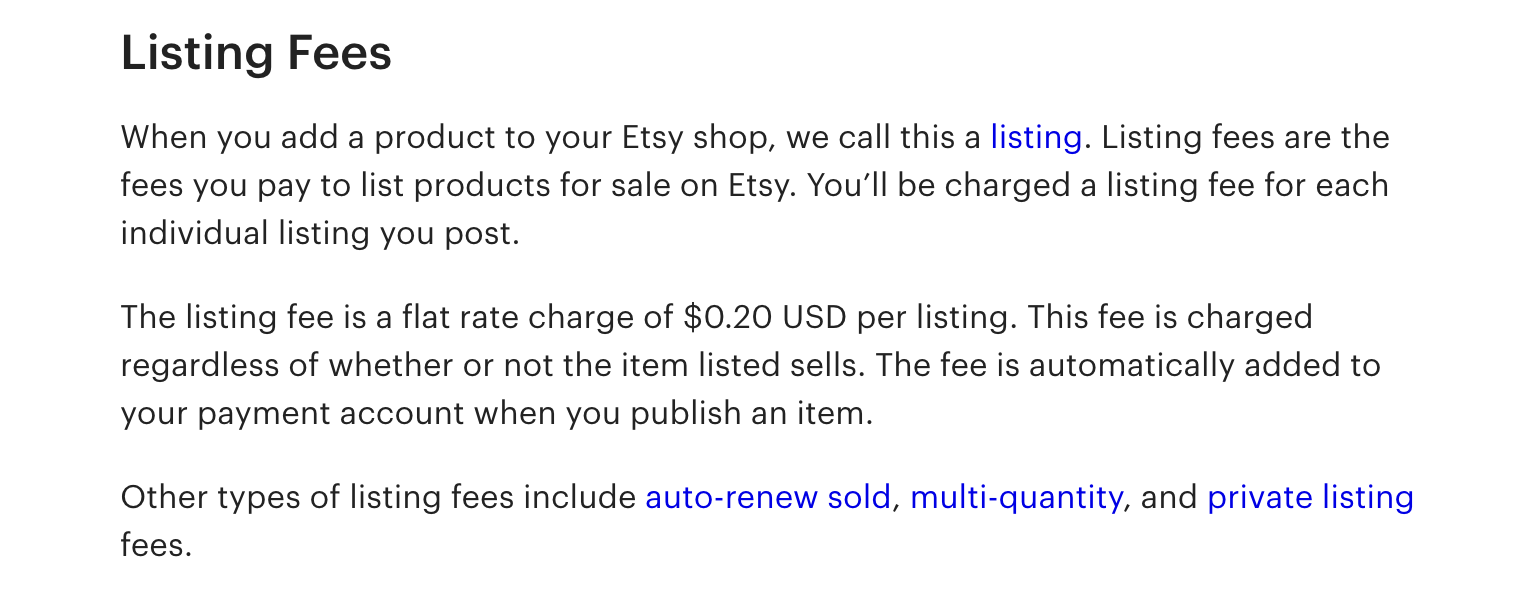
Etsy’s listing fee policy
Pros:
- Upfront Revenue: The platform earns money when sellers pay listing fees to showcase their products or services, providing a steady source of income.
- Quality Control: Charging a listing fee can ensure that only serious sellers with genuine offerings become part of the online marketplace business.
Cons:
- Entry Barrier: For small or new businesses, upfront listing fees can be a hurdle, limiting participation.
- Risk of Overpricing: Sellers might increase their prices to cover listing fees, potentially affecting competitiveness.
Understanding the dynamics of a listing fee model sheds light on how online marketplaces charge sellers for showcasing their goods or services on their digital shelves, forming a crucial part of their revenue models and revenue strategy.
In marketplaces, the listing fee revenue model means sellers pay a fee to show their products on the marketplace’s storefront.
#3. Subscription-Based Marketplace Business Model
The subscription business model in eCommerce marketplaces revolves around sellers paying a recurring fee to access and use the platform's services for a set period. It's like a membership where sellers get ongoing benefits in exchange for their subscription.
Under the subscription-based revenue model, buyers and sellers commit to paying a recurring fee, often monthly or annually, to maintain an active presence on the platform. This ongoing payment grants them continued access to the platform's features, such as increased visibility, marketing tools, or premium features.
Examples:
- Amazon: Amazon offers a Professional seller plan for $39.99 per month, which includes features like bulk listing tools, advertising credits, and access to Amazon's Brand Registry.
- CouchSurfing: Starting in 2020, when registering on Couchsurfing, new users are required to pay a nominal fee to access the platform, a measure implemented in response to financial challenges stemming from COVID-19. The fee amounts to $2.99 per month or $17.99 per year, covering platform access and user verification.
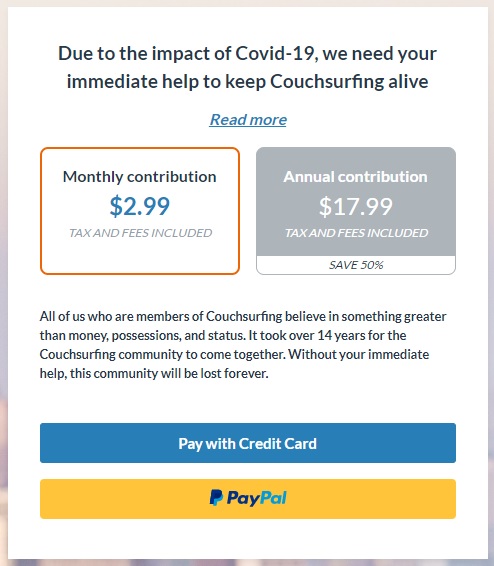
Couchsurfing subscription plans
Pros:
- Steady Income: The subscription fees provide a predictable and steady income stream for the online marketplace.
- Enhanced Services: Buyers and sellers subscribing to premium plans often receive additional services, fostering loyalty.
Cons:
- Risk of Inactivity: Buyers and sellers who pay a subscription but don't actively use the platform may lead to underutilization.
- Affordability: Small businesses may find subscription fees a financial challenge, impacting their participation.
Understanding the subscription-based revenue model reveals how marketplaces create a symbiotic relationship with buyers and sellers, providing ongoing benefits in exchange for regular fees—a dynamic approach to sustaining the platform's vitality, including features such as payment processing to facilitate transactions.
In online marketplaces that use a subscription model, sellers pay a recurring fee to access and use the platform's services periodically.
#4. Freemium Marketplace Business Model
The freemium model in successful marketplaces allows users to access basic features for free, while offering premium, enhanced features. Users pay additionally for these features. It's a strategy where the platform provides a taste of its offerings without upfront charges, enticing users to opt for advanced features through paid subscriptions.
Under the freemium model, sellers can use the basic functionalities of the platform without any cost. However, to unlock additional features or enjoy an enhanced experience, sellers are encouraged to subscribe to a premium, paid plan. This revenue model is like offering a free sample at a store, with the option to purchase the full package for more benefits.
Examples:
- Craigslist: Craigslist is a classified ads platform that allows users to post and browse ads for free. However, it also offers paid options for users who want to highlight their ads or post ads for a longer duration.
- Cratejoy: Cratejoy is a marketplace where sellers offer subscription boxes for different interests. The platform offers an accessible Marketplace Only plan for free, and also provides the All-in-One plan for $39 per month, which includes additional features.
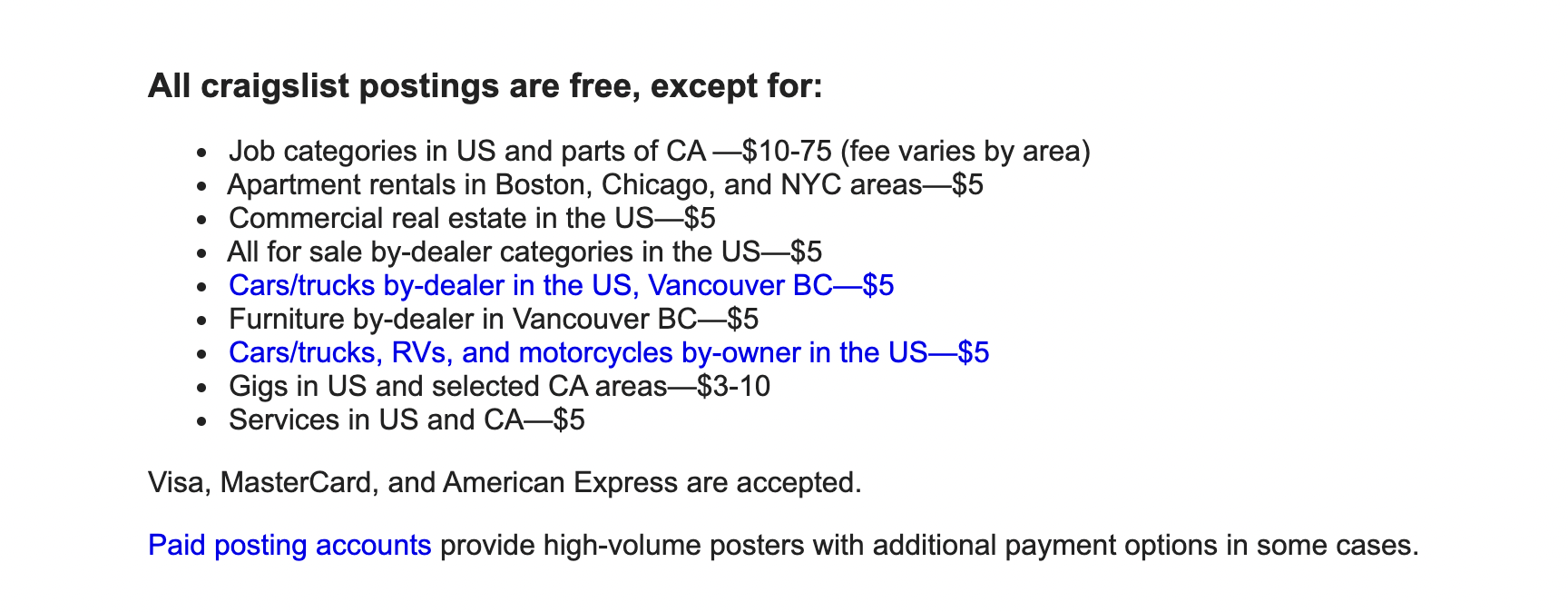
Craigslist paid services
Pros:
- User Acquisition: The free tier attracts a large user base, allowing the platform to acquire users without imposing upfront costs.
- Flexible Upgrade: Users can upgrade to paid features based on their needs, providing a flexible and scalable revenue strategy.
Cons:
- Limited Features: Free users have access to basic features but may miss out on advanced functionalities available in the premium version.
- Conversion Challenge: Convincing free users to upgrade can be challenging, requiring a compelling value proposition for the premium offering.
Understanding the freemium model unveils how online marketplaces balance accessibility with revenue generation, offering a pathway for users to enhance their experience through optional paid subscriptions. This approach ensures a successful marketplace startup by targeting the right market and fostering seamless and secure transactions, often featuring additional revenue streams like fixed or variable fees for premium services or listings.
In the freemium revenue model, sellers access basic platform features for free. To enjoy extra perks, they can subscribe to a premium, paid plan.
#5. Advertising and Sponsorship Model
The advertising and sponsorship model in an online marketplace business model involves generating revenue by allowing businesses to promote their products or services on the platform through featured listings and ads. It can include display advertising, sponsored content, or partnerships, creating a symbiotic relationship between the marketplace owner, advertisers, and users.
Under the advertising and sponsorship model, businesses pay to showcase their offerings to the platform's user base. Basically they pay for featured listings and ads. This can take various forms, such as display ads on the website, sponsored listings, or even partnerships with the marketplace owner. The revenue stream is generated through advertising fees, creating a marketplace revenue model where sellers can enhance their visibility through paid promotions.
Examples:
- Craigslist: Craigslist is a classified ads platform that allows users to post and browse ads for free. However, it also offers paid options for users who want to highlight their ads or post ads for a longer duration.
- Zillow: Zillow stands out as the leading platform, where agents and management companies incur charges for promoting their listings through advertising services on the platform.
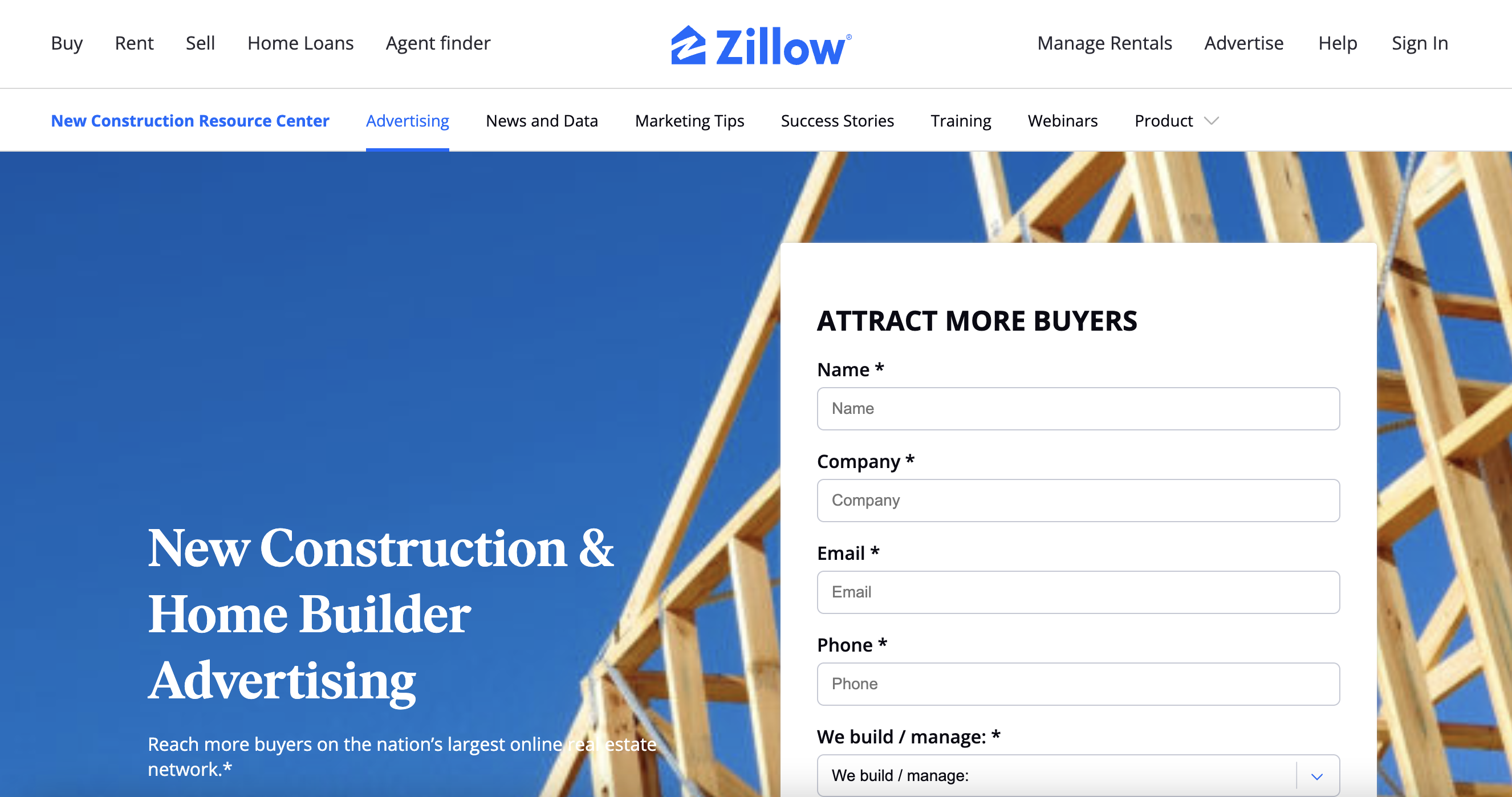
Advertising opportunities at Zillow marketplace
Pros:
- Diverse Revenue Streams: The advertising and sponsorship model introduces additional streams beyond transaction-based fees.
- Enhanced Visibility: Sellers can gain increased visibility and exposure to a broader audience through paid featured listings and ads, attracting buyers effectively.
Cons:
- User Experience Impact: Excessive or intrusive ads may impact the UX, leading to dissatisfaction.
- Balancing Act: Striking the right balance between ads and UX is crucial to maintaining a positive business platform environment.
Understanding the advertising and sponsorship model sheds light on how online marketplaces leverage partnerships and promotions to create a dynamic ecosystem, balancing the needs of advertisers, users, and the marketplace owner itself. This strategic approach becomes an integral part of the overall business plan, especially for niche marketplaces aiming to offer a better value proposition to their audience.
In a marketplace business model, advertising and sponsorship generate revenue by letting businesses promote products or services on the platform.
#6. Affiliate Marketing Model
The affiliate marketing model in a marketplace business model revolves around partnering with external individuals or businesses (affiliates) who promote products or services on the platform. Affiliates earn a commission for each sale or lead generated through their referral efforts, creating a performance-based and mutually beneficial system.
Under the affiliate marketing model, external affiliates promote products or services listed on the platform through unique tracking links. When a referred potential client makes a purchase or completes a desired action, the affiliate earns a commission. This model aligns the interests of the marketplace, affiliates, and sellers, creating a symbiotic relationship where everyone benefits from successful transactions.
Examples:
- Amazon Associates: Amazon's affiliate program allows individuals to promote Amazon products and earn a commission for each sale generated through their unique affiliate links.
- ShareASale: ShareASale is an affiliate marketing network that connects affiliates with various merchants, enabling them to earn commissions for promoting products or services.
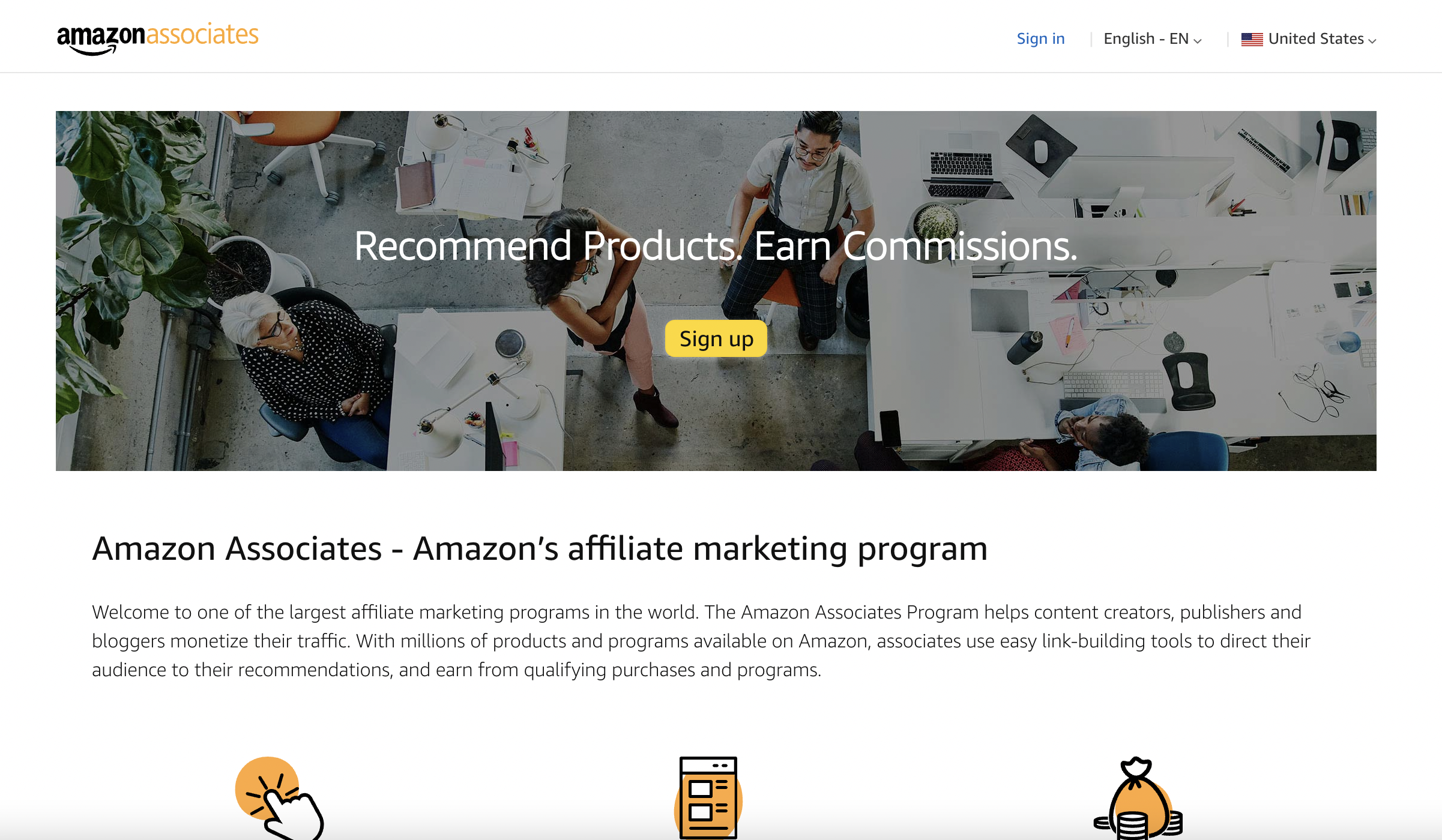
Amazon Associates affiliate program
Pros:
- Performance-Based: Affiliates earn commissions based on actual sales or leads, ensuring a direct correlation between effort and reward.
- Expanded Reach: Affiliates contribute to expanding the marketplace's reach by leveraging their own networks and platforms.
Cons:
- Dependency: Success relies on effective affiliate marketing strategies, and the marketplace may face challenges if affiliates are not generating sufficient sales.
- Commission Costs: While performance-based, commission payments can accumulate, impacting the overall cost structure for the marketplace.
Understanding the affiliate marketing model unveils how online marketplaces leverage external partnerships to drive sales and expand their reach. This model is particularly effective for attracting partners with niche audiences, contributing to a diverse and dynamic ecosystem with several money streams. Additionally, it ensures that financial transactions are secure, helping the platform typically sustain revenue while reaching a global audience as affiliates actively promote and sell products.
In the affiliate marketing model of a marketplace business, external affiliates earn commissions by promoting products or services on the platform, fostering a performance-based and mutually beneficial system through referral efforts.
Choosing the Right Marketplace Business Model for Your Business Goals
Selecting the optimal marketplace business model for an online marketplace is a nuanced process, and several factors should be carefully considered to align the chosen model with the marketplace's goals and target audience. Here's a detailed breakdown of the main factors and common marketplace business models for specific online marketplace types:
1. Commission-Based Model
Factors to Consider:
- Transaction Dynamics: Analyze the volume and value of transactions on the platform. A commission-based model is well-suited for marketplaces facilitating numerous transactions.
- User Willingness to Pay: Assess whether users are willing to pay a percentage for successful transactions, considering market expectations and industry standards.
Common for: General e-commerce platforms, service marketplaces.
2. Listing Fee Model
Factors to Consider:
- Product or Service Value: Evaluate the value of listed products or services. A listing fee model is effective for marketplaces with high-value items.
- Revenue Accessibility: Balance the need for upfront revenue with ensuring accessibility for a diverse range of sellers.
Common for: Niche marketplaces, platforms with unique or high-value items.
3. Subscription Model
Factors to Consider:
- Frequency of Usage: Examine how often users engage with the platform. A subscription model is suitable when users have regular and ongoing needs.
- Value Proposition: Assess the ability to provide continuous value to subscribers through paid features, services, or content.
Common for: SaaS marketplaces, platforms with specialized services or content.
4. Freemium Model
Factors to Consider:
- Basic Features Appeal: Evaluate the attractiveness of basic features to attract a wide user base. A freemium model is effective when the free offering provides significant value.
- Conversion Potential: Assess the potential for converting free users to paid subscribers based on the perceived value of premium features.
Common for: Social networking platforms, software applications.
5. Advertising and Sponsorship Model
Factors to Consider:
- User Experience: Consider the tolerance of the user base for ads and sponsored content. Maintaining a positive UX is crucial.
- Revenue Potential: Evaluate the revenue potential from partnering with advertisers and sponsors, considering the target audience and market demand.
Common for: Social media platforms, content-driven online marketplaces.
6. Affiliate Marketing Model
Factors to Consider:
- External Networks: Assess the ability to leverage external networks for product or service promotion. Affiliate marketing is effective when external partners can drive traffic.
- Product Suitability: Consider whether the products or services offered are conducive to affiliate marketing and if external promotion aligns with online marketplace business goals.
Common for: E-commerce platforms, content-rich online marketplaces.
Choosing the Right Mix:
Assess the online marketplace's unique characteristics and potential synergies between different marketplace business models. A mixed model, incorporating multiple revenue streams, can often be profitable.
By delving into these nuanced considerations, marketplace owners can make informed decisions about the most fitting marketplace business model or combination of marketplace business models. This detailed analysis ensures not only revenue maximization but also the creation of a sustainable and thriving online marketplace.
Why Is CS-Cart Multi-Vendor One of the Best Platforms for Diverse Marketplace Business Models?
In navigating the intricacies of choosing the right online marketplace business model, CS-Cart Multi-Vendor emerges as your dynamic ally. Seamlessly adaptable to any vision, this marketplace software excels in versatility, customizability, and scalability.
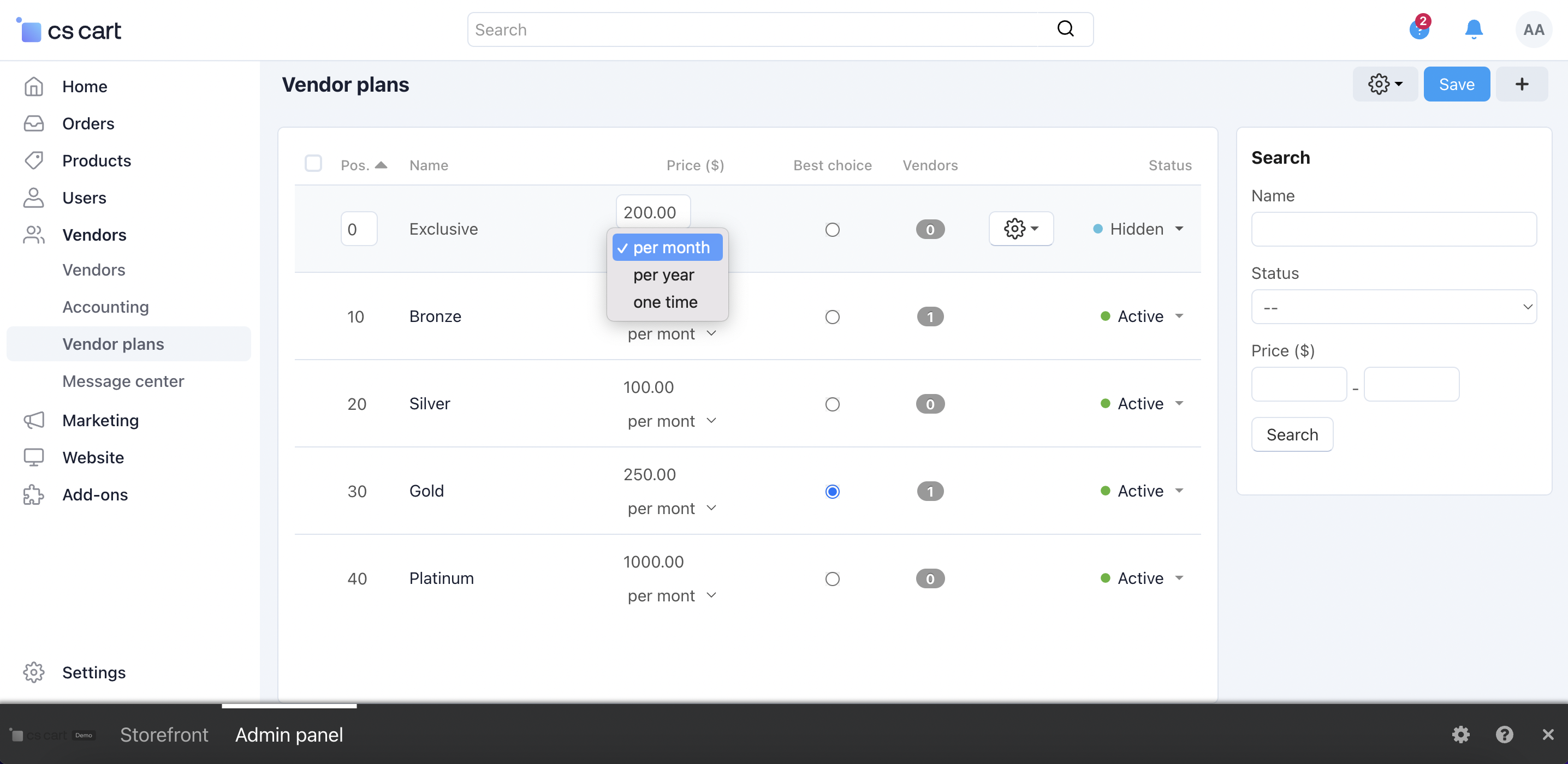
Configurable subscription plans for sellers in CS-Cart
Whether it's a commission-based model, subscription model, or the innovative freemium model, CS-Cart Multi-Vendor supports these top marketplace business models out of the box. Tailoring to a listing fee model or exploring an advertising and sponsorship model? This platform integrates effortlessly, promoting seamless and secure transactions for both buyers and sellers.
CS-Cart Multi-Vendor isn't confined to a niche—it thrives in diverse ecosystems. Whether you're developing online marketplaces for consumer-to-consumer interactions or launching a marketplace startup for global commerce, this software provides the tools for success.
Moreover, if you're considering a hybrid approach, combining various models for a dynamic revenue mix, CS-Cart Multi-Vendor gracefully supports this too. It's not just a platform; it's a canvas where your marketplace vision transforms into reality.
Ready to explore the possibilities? Try the CS-Cart Multi-Vendor free demo and witness your marketplace business rise to new heights. Your success story begins here.

